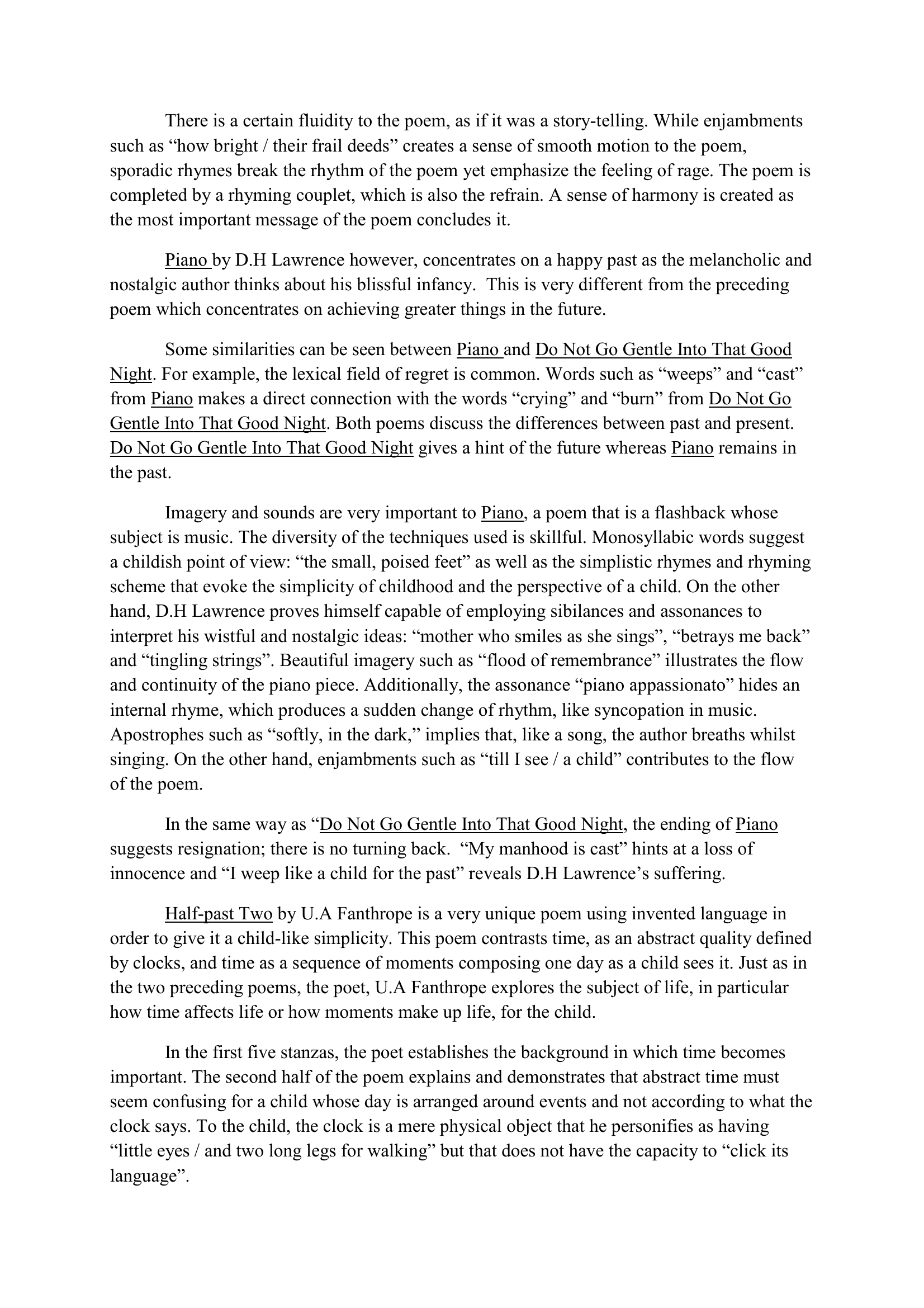These poems explore encounters between the speaker or a character and a force that is greater than he is – How do the poets develop and contemplate this experience? Refer to the details of language and effect as you compare these poems.
Publié le 30/03/2012
Extrait du document


«
There is a certain fluidity to the poem, as if it was a story-telling.
While enjambments
such as “how bright / their frail deeds” creates a sense of smooth motion to the poem,
sporadic rhymes break the rhythm of the poem yet emphasize the feeling of rage.
The poem is
completed by a rhyming couplet, which is also the refrain.
A sense of harmony is created as
the most important message of the poem concludes it.
Piano by D.H Lawrence however, concentrates on a happy past as the melancholic and
nostalgic author thinks about his blissful infancy.
This is very different from the preceding
poem which concentrates on achieving greater things in the future.
Some similarities can be seen between Piano and Do Not Go Gentle Into That Good
Night.
For example, the lexical field of regret is common.
Words such as “weeps” and “cast”
from Piano makes a direct connection with the words “crying” and “burn” from Do Not Go
Gentle Into That Good Night.
Both poems discuss the differences between past and present.
Do Not Go Gentle Into That Good Night gives a hint of the future whereas Piano remains in
the past.
Imagery and sounds are very important to Piano, a poem that is a flashback whose
subject is music.
The diversity of the techniques used is skillful.
Monosyllabic words suggest
a childish point of view: “the small, poised feet” as well as the simplistic rhymes and rhyming
scheme that evoke the simplicity of childhood and the perspective of a child.
On the other
hand, D.H Lawrence proves himself capable of employing sibilances and assonances to
interpret his wistful and nostalgic ideas: “mother who smiles as she sings”, “betrays me back”
and “tingling strings”.
Beautiful imagery such as “flood of remembrance” illustrates the flow
and continuity of the piano piece.
Additionally, the assonance “piano appassionato” hides an
internal rhyme, which produces a sudden change of rhythm, like syncopation in music.
Apostrophes such as “softly, in the dark,” implies that, like a song, the author breaths whilst
singing.
On the other hand, enjambments such as “till I see / a child” contributes to the flow
of the poem.
In the same way as “Do Not Go Gentle Into That Good Night, the ending of Piano
suggests resignation; there is no turning back.
“My manhood is cast” hints at a loss of
innocence and “I weep like a child for the past” reveals D.H Lawrence’s suffering.
Half-past Two by U.A Fanthrope is a very unique poem using invented language in
order to give it a child-like simplicity.
This poem contrasts time, as an abstract quality defined
by clocks, and time as a sequence of moments composing one day as a child sees it.
Just as in
the two preceding poems, the poet, U.A Fanthrope explores the subject of life, in particular
how time affects life or how moments make up life, for the child.
In the first five stanzas, the poet establishes the background in which time becomes
important.
The second half of the poem explains and demonstrates that abstract time must
seem confusing for a child whose day is arranged around events and not according to what the
clock says.
To the child, the clock is a mere physical object that he personifies as having
“little eyes / and two long legs for walking” but that does not have the capacity to “click its
language”..
»
↓↓↓ APERÇU DU DOCUMENT ↓↓↓
Liens utiles
- Franklin Roosevelt's Pearl Harbor Speech In this famous speech, President Franklin Delano Roosevelt lists the unprovoked attacks by Japan and details America's reasons for declaring war.
- William Faulkner I INTRODUCTION William Faulkner Twentieth-century American novelist William Faulkner wrote novels that explored the tensions between the old and the new in the American South.
- Islamic Art and Architecture I INTRODUCTION Córdoba Mosque Courtyard This mosque and courtyard with its repeated horseshoe arches was built between the 8th and 10th centuries in Córdoba, Spain.
- Mesopotamian Art and Architecture I INTRODUCTION Mesopotamian Art and Architecture, the arts and buildings of the ancient Middle Eastern civilizations that developed in the area (now Iraq) between the Tigris and Euphrates rivers from prehistory to the 6th century BC.
- Calculus (mathematics) I INTRODUCTION Limits This graph, which charts the function f(x)=1x, shows that the value of the function approaches zero as x becomes larger and larger.

































